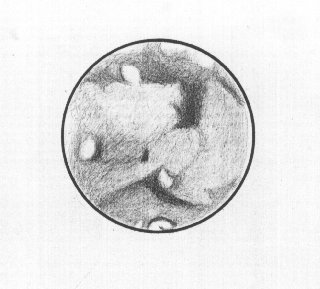Id-076D 10 Mar (089degreeLs) LCM=231degreeW Id-077D LCM=241degreeW Id-078D LCM=250degreeW Id-079D LCM=260degreeW Id-080D LCM=270degreeW Id-081D LCM=280degreeW Id-082D LCM=289degreeW Id-083D LCM=302degreeW

Elysium was apparent from the outset (Id-076D), but it became very evident from around Id-079D. In Id-082D, Elysium was near the terminator and nearly vanished in Id-083D. Id made also at LCM=300degreeW on 9 Mar where the situation was the same. On 10 Mar the phase angle was 07degree, and Elysium was at around 4 o'clock local time when Id-080D (LCM=270degreeW) was made.
Elysium Mons described by Id became whitish bright in the deep afternoon and hence this phenomenon was caused by such a white orographic cloud as reviewed in Mars Sketch (3) in No 201.
Fig. ISHADOH's drawing (Id-080D) on 10 Mar 1997 (089degreeLs)
at LCM=270degreeW showing a very whitish bright cloud at Elysium Mons
At Fukui, NAKAJIMA (Nj) made a similar continual observations of the afternoon Elysium on 8 March (088degreeLs). On the day he witnessed that Elysium was whitish bright enough at LCM=244degreeW. On the following day on 9 Mar (088degreeLs), Nj however saw the off-white tint remain at the region of Elysium at LCM=235degreeW. MINAMI (Mn) on 9 Mar detected Elysium Mons through O56 atLCM=220degreeW while it became well whitish at LCM=240degreeW and very brilliant at LCM=260degreeW. Nj and Mn watched the region from 7 Mar to 11 Mar as follows:
Mn-332D 7 Mar (087degreeLs) LCM=248degreeW Nj-093D LCM=252degreeW Mn-333D LCM=257degreeW Nj-094D LCM=262degreeW Mn-334D LCM=267degreeW Nj-095D LCM=272degreeW Mn-335D LCM=277degreeW Nj-096D LCM=282degreeW Nj-097D 8 Mar (088degreeLs) LCM=224degreeW Nj-098D LCM=234degreeW Nj-099D LCM=244degreeW Nj-100D LCM=253degreeW Nj-101D LCM=263degreeW Nj-102D LCM=273degreeW Nj-103D 9 Mar (087degreeLs) LCM=215degreeW Mn-336D LCM=220degreeW Nj-104D LCM=225degreeW Mn-337D LCM=230degreeW Nj-105D LCM=235degreeW Mn-338D LCM=240degreeW Nj-106D LCM=245degreeW Mn-339D LCM=250degreeW Nj-107D LCM=255degreeW Mn-340D LCM=259degreeW Mn-341D LCM=272degreeW Mn-342D LCM=281degreeW Mn-343D LCM=291degreeW Mn-344D LCM=301degreeW Mn-348D 11 Mar (089degreeLs) LCM=203degreeW Mn-349D LCM=230degreeW Mn-350D LCM=240degreeW Mn-351D LCM=249degreeW Mn-352D LCM=259degreeW Mn-353D LCM=271degreeW Mn-354D LCM=281degreeW Mn-355D LCM=291degreeW Nj-110D LCM=295degreeW Mn-356D LCM=300degreeW Nj-111D LCM=305degreeW Mn-357D LCM=310degreeW Nj-112D LCM=315degreeWWe also have other observations among which the following are included:
Mo-054CCD 11 Mar (089degreeLs) LCM=250degreeW Id-084D 11 Mar (089degreeLs) LCM=251degreeW Id-085D LCM=261degreeW Id-086D LCM=271degreeW Id-087D LCM=281degreeW Mn-358D 12 Mar (090degreeLs) LCM=216degreeW Mn-359D LCM=226degreeW Mn-360D LCM=236degreeW Mn-361D LCM=245degreeW Mn-362D LCM=255degreeW Mk-135D 12 Mar (090degreeLs) LCM=260degreeW Id-088D 13 Mar (090degreeLs) LCM=212degreeW Id-089D LCM=222degreeW Id-090D LCM=232degreeWwhere Mo=MORITA, and Mk=MURAKAMI.
In the Mo image the afternoon Elysium is bright even though it was taken in Red. As seen from the example by MURAKAMI, Elysium this time proved most conspicuously whitish at LCM=250degreeW - LCM=260degreeW. The observations by Mn on 12 Mar was at Otsu, and Elysium Mons was detected at LCM=226degreeW.
We have described mainly the trend of Elysium, but the region made of Cebrenia was also interestingly bright throughout the period.
We also note that the afternoon Elysium shows the characteristic aspect in the Video images taken by HIGA (Hg) on 9 Mar, 10 Mar and 11 Mar. On 10 Mar at LCM=218degreeW, Elysium looks more whitish and brighter than Hellas. On the other hand the morning Elysium on the image on 15 Mar is not so whitish though bright.
Elysium still faced to us. On 17 Mar (092degreeLs) at LCM=192degreeW, Elysium Mons was seen and the Elysium region of the morning was traced until 22 Mar. For example, in the observation:
Mk-141D 20 Mar (093degreeLs) LCM=186degreeWthe morning Elysium and Cebrenia were apparent.
Elysium came into sight again in mid-April. The Y-shaped Elysium-Cebrenia region was still light. But the apparent diameter went down to 12 arcsecs, and we could not catch well the activity of Elysium Mons. On 23 Apr (108degreeLs) at LCM=206degreeW (Mn-554D), there were seen a few areas of bright spots inside Elysium, but looked somewhat off-white. Id also recorded on 20 Apr (107degreeLs) at LCM=241degreeW (Id-110D) that Elysium was off-white. A CCD Red image by AKUTSU (Ak) shows a light Elysium on 22 Apr at LCM=235degreeW.
Around 20 Apr (107degreeLs), the morning Elysium and the following area showed a white-cloud burst as seen visually and as proved by the Video images by Hg as reported in Sketch (1) in No 197 (see also No 204). The cloud was thought as the one developed from the morning mist which covers frequently the morning Syrtis Mj to make it to be quite blue-greenish in this season.
Finally we record an aspect of Elysium in Feb 1997 from the notes of the present writer: Elysium was visible from around 5 Feb (074degreeLs). Elysium and Cebrenia were light enough in a Y-shape, and on 7 Feb (075degreeLs) at LCM=241degreeW, there was seen an activity inside Elysium. On 8 Feb (076degreeLs) at LCM=222degreeW, Elysium was off-white yet, but at LCM=242degreeW more whitish than Cebrenia. On 10 Feb (076degreeLs) at LCM=194degreeW, Elysium was not white but at LCM=233degreeW became bright. The apparent diameter was less than 12 arcsecs however.
(Mn : Masatsugu MINAMI)